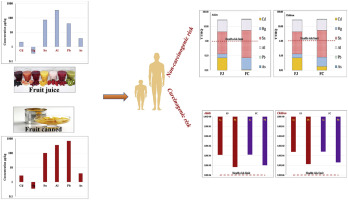Food and Chemical Toxicology ( IF 4.3 ) Pub Date : 2018-04-03 , DOI: 10.1016/j.fct.2018.03.044 Ayub Ebadi Fathabad , Nabi Shariatifar , Mojtaba Moazzen , Shahrokh Nazmara , Yadolah Fakhri , Mahmood Alimohammadi , Ali Azari , Amin Mousavi Khaneghah

|
In this study, the levels of Cd, Hg, Sn, Al, Pb and As of 72 samples (36 samples for fruits juices and 36 samples for fruits canned) of three different brands including of Peach, Orange, Cherry, and Pineapple (18 samples of each fruits) marketed in Tehran, Iran (2015) were evaluated using Inductively Coupled Plasma-Optical Emission Spectrometry (ICP-OES) technique. Also, Probabilistic risk assessment (non-carcinogenic and carcinogenic risks) was estimated by models include target hazard quotient (THQ) and cancer risk (CR) in the Monte Carlo Simulation (MCS) model. However, all samples were contaminated with the heavy metals investigated, most of them not surpassed established standards. The range of concentration for Al, Sn, As, Cd, Hg, and Pb as average in fruit juices were reported as 340.62 (65.17–1039.2), 72.33 (49.76–119.4), 3.76 (1.137–18.36), 2.12 (0.89–3.44), 0.351 and 40.86 (27.87–66.1) μg/kg, respectively. The level of heavy metals measured in different kinds of fruit juices was ranked as Al > Sn > Pb > As > Cd > Hg, and for fruits canned this rank was Pb > Al > Sn > As > Cd > Hg. The range of concentration for Al, Sn, As, Cd, Hg, and Pb in fruits canned were reported as 361.23 (43.15–1121.2), 101.42 (71.45–141.61), 3.92 (1.279–19.50), 2.78 (1.09–5.56), 0.35 and 690.54 (470.56–910.14) μg/kg, respectively. The lead (Pb) concentration in 97.22% (35 out of 36 samples) of fruit juices samples surpassed Codex limit (0.05 mg/kg) and in all samples of FC was lower than the legal limit of Codex limit (1 mg/kg). All of the samples had Tin (Sn) lower than the legal limit of Codex (fruit juices 100 mg/kg and FC 250 mg/kg). The MCS indicated that the rank order of heavy metals in both adults and children based on THQ was Al > Sn > As > Pb > Cd > Hg. The THQ of Al and Sn in the FJ and FC, for both adults, and children, was considerably higher than 1 value. Also, CR of As in both adults and children were higher than 1E-6 value. Although the mean concentration of heavy metal in the FJ and FC was lower than the standard limit, the MCS indicated that adults and children are at considerable non-carcinogenic and carcinogenic risks.
中文翻译:

使用ICP-OES测定德黑兰市场加工的水果产品中的重金属含量:一项风险评估研究
在这项研究中,包括桃子,橙子,樱桃和菠萝在内的三个不同品牌的72个样品(果汁样品36个,罐装水果样品36个)中Cd,Hg,Sn,Al,Pb和As的水平(18使用感应耦合等离子体发射光谱(ICP-OES)技术对在伊朗德黑兰(2015)销售的每种水果的样品进行了评估。同样,概率风险评估(非致癌和致癌风险)是通过包括蒙特卡罗模拟(MCS)模型中的目标风险商(THQ)和癌症风险(CR)的模型进行估算的。但是,所有样品均被调查的重金属污染,其中大多数未超过既定标准。据报告,果汁中Al,Sn,As,Cd,Hg和Pb的平均浓度范围分别为340.62(65.17–1039.2),72.33(49.76–119.4),3.76(1.137–18)。36),2.12(0.89–3.44),0.351和40.86(27.87–66.1)μg/ kg。在不同种类的果汁中测得的重金属含量为Al> Sn> Pb> As> Cd> Hg,对于罐头水果,该等级为Pb> Al> Sn> As> Cd> Hg。罐装水果中Al,Sn,As,Cd,Hg和Pb的浓度范围据报道为361.23(43.15-1121.2),101.42(71.45-141.61),3.92(1.279-19.50),2.78(1.09-5.56) ,0.35和690.54(470.56–910.14)μg/ kg。果汁样品中的97.22%(36个样品中的35个)中的铅(Pb)浓度超过了法典限值(0.05 mg / kg),并且所有FC样品中铅的含量均低于法典限值的法定限值(1 mg / kg) 。所有样品中的锡(Sn)均低于法典的法定限值(果汁100 mg / kg和FC 250 mg / kg)。MCS表明,基于THQ的成年人和儿童中重金属的排位顺序为:Al> Sn> As> Pb> Cd> Hg。无论是成人还是儿童,FJ和FC中的Al和Sn的THQ都大大高于1。而且,成人和儿童的砷的CR均高于1E-6值。尽管FJ和FC中的重金属平均浓度低于标准限值,但MCS指出,成人和儿童面临相当大的非致癌和致癌风险。



























 京公网安备 11010802027423号
京公网安备 11010802027423号